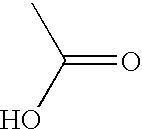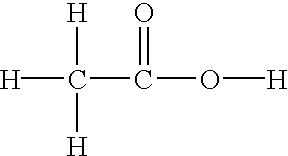Formulations and methods for straightening hair
a technology of curling and hair, applied in the direction of biocide, hair cosmetics, impression caps, etc., can solve the problems of hair, skin and scalp damage, hair damage, and the risk of hair and skin damage of bisulfite straighteners
- Summary
- Abstract
- Description
- Claims
- Application Information
AI Technical Summary
Problems solved by technology
Method used
Image
Examples
example 2
Thus, this formulation in combination contains a total concentration of acetic acid of about 2% w / w. The formulation is referred to as a "leave in" formulation as it is intended to be applied to the hair in gel form without subsequent rinsing.
According to one method of application, the formulation is applied to wet, clean hair and combed through. The hair is set with curlers or other styling aids and blown dry. The formulation is not rinsed out. The hair will gradually straighten with repeated use.
The formulation also may be applied to dry hair as a spray formulation to control frizz and as a setting agent between shampoos.
example 3
Thus, this formulation in combination contains a total concentration of acetic acid of about 0.6% w / w. The product may also be formulated with glacial acetic acid (pure) and deionized water to equal a 10% acetic acid ingredient. This formulation is designed to gradually straighten moderately curly hair, reduce frizz, and prevent curling of straightened hair (e.g., as maintenance). According to one method of application, the formulation is applied to wet, clean hair and combed through. The hair may be allowed to dry naturally, set with curlers or other styling aids, or blown dry. The formulation is not rinsed out. The hair will gradually straighten with repeated use or maintain straightness achieved with previous treatment, particularly during humid weather. The formulation also may be applied to dry hair as a spray formulation to control frizz and as a setting agent between shampoos.
example 4
The formulation of Example 1 was prepared as follows. 24.475 kg. of 10% acetic acid (aqueous) was weighed and transferred into a colloid mill circulation tank. 100 gms. of fragrance were then added to the mixing tank while agitating slowly. 425 gms. of XANTURAL.RTM. 11K gum powder were added to the hopper of the colloid mill circulation while the liquid was circulating to ensure good wetting of the powder. After all the gum power was added, the solution was circulated for 15-30 minutes or until the solution was uniform. A sample was taken from the tank and the viscosity measured with a Brookfield viscometer with an appropriate spindle. The pH and density were measured, and the solution transferred to the filler feed tank. The result is a bath of about 25 kg (approx. 55 lbs) of a formulation having the constituents as set forth above in Example 1.
PUM
| Property | Measurement | Unit |
|---|---|---|
| Fraction | aaaaa | aaaaa |
| Fraction | aaaaa | aaaaa |
| Fraction | aaaaa | aaaaa |
Abstract
Description
Claims
Application Information
 Login to View More
Login to View More - R&D
- Intellectual Property
- Life Sciences
- Materials
- Tech Scout
- Unparalleled Data Quality
- Higher Quality Content
- 60% Fewer Hallucinations
Browse by: Latest US Patents, China's latest patents, Technical Efficacy Thesaurus, Application Domain, Technology Topic, Popular Technical Reports.
© 2025 PatSnap. All rights reserved.Legal|Privacy policy|Modern Slavery Act Transparency Statement|Sitemap|About US| Contact US: help@patsnap.com



